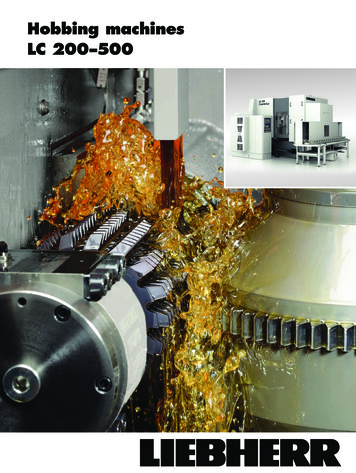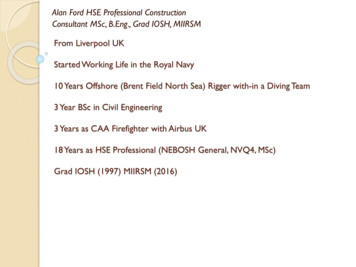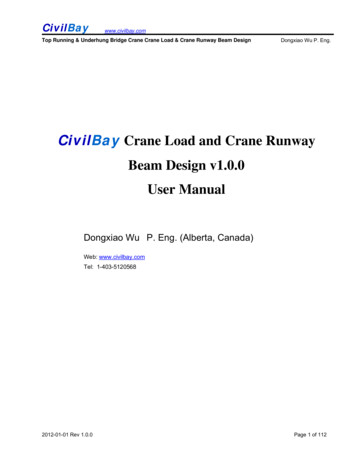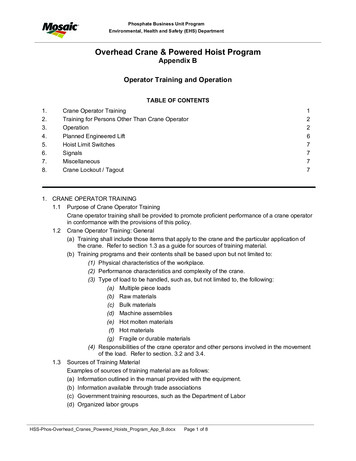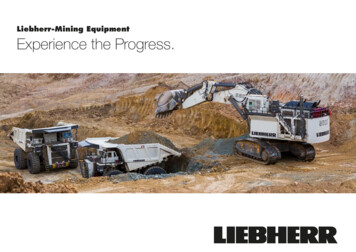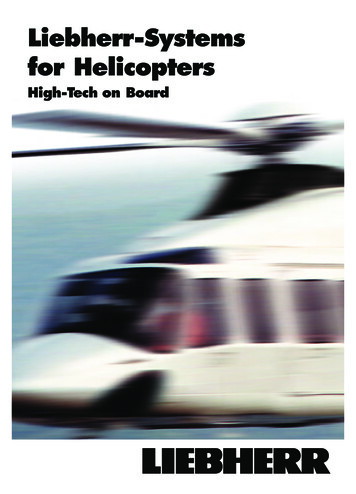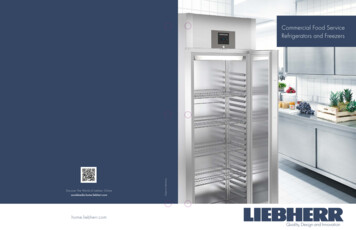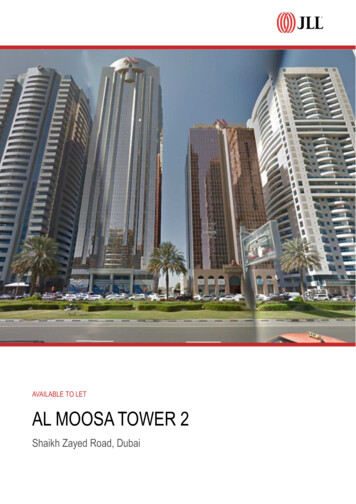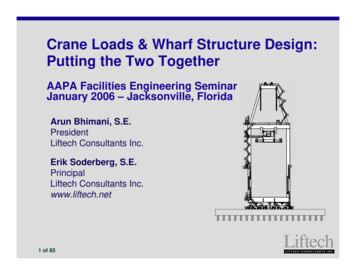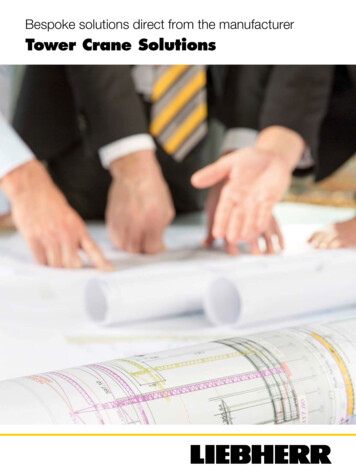
Transcription
Bespoke solutions direct from the manufacturerTower Crane Solutions
Table of contentsAirport extension in Santiago de Chile4–5City life in Milan6–7The highest building in Europe8–9Complete solution for modern construction10 – 11Performance in the Big Apple12 – 13Building with concrete modules made easy14 – 15From planning to dismantling from a single source16 – 17Power plant construction in Greece18 – 19Time-tested in mines20 – 21A striking bridge in Kuwait22 – 23Major modification project on the Molikpaq offshore platform24 – 25Tower Crane Solutions3
Airport extension in Santiago de Chile4Tower Crane Solutions
23 Liebherr EC-B and EC-H series tower cranesThe Liebherr Tower Cranes Division is once again demonstrating its expertise in airport construction – a totalof 23 Liebherr tower cranes is working on the expansion of the “Santiago Nueva Pudahuel International” inChile, 15 flat-top cranes and three high-top cranes have already been erected and are providing excellent loadhandling services.The airport in Santiago de Chile is building on its reputationas one of the most important hubs in South America. Theoperators are expanding the site to 265,000 m² and haveplaced an order for an additional terminal. When it is completed, the airport will more than double its overall capacityto 30 million passengers per year. The number of passengerboarding bridges will rise from 18 to 67. The number of carparking spaces will also be doubled.Liebherr tower crane fleet in actionThe developer is completing the project using 23 Liebherr towercranes. Seven 250 EC-B 12 Litronic cranes, four 150 EC-B 8Litronic cranes and a 280 EC-H 16 Litronic have already beenerected by Liebherr-Chile S.p.A. In addition, six cranes fromChilean dealer Maquinarias Cruz del Sur are already in action – a 280 EC-H 12 Litronic, two 200 EC-H 10 Litronic andthree 90 EC-B cranes. Since the end of 2016, the 18 towercranes have been operating in double shifts on the site withjib lengths of 45 to 60 m and hook heights of 17 to 45 m. Atthe current time, around 70 percent of the work on the airporthas been completed. Additional Liebherr tower cranes will berequired to build the car parks – probably three 110 EC-B 6cranes and two 154 EC-H models.Limited erection height for cranesLiebherr’s Tower Crane Solutions Project Department advised and helped the consortium in planning how to coverthe large construction site in the most cost-effective way. Theimportant things during planning are to select the correctcrane types, their quantity, positioning and dimensions. Theconstruction site situation plays a major role in this process.For airport construction, for example, the maximum craneheights are very limited. To ensure that it is possible to operatelots of cranes in a very constricted area, the service technicians erected a 250 EC-B 12 Litronic flat-top crane on railsfor building one of the terminals. This means that the cranecan cover a large part of the site and when it is not operating,it can be moved into a position in which it can slew freely. Foradditional safety, all the cranes are fitted with an anti-collisionsystem supplied by French manufacturer AMCS technologies.There have been several rounds of negotiations regarding theairport in Santiago with the consortium especially createdfor this project between construction contractors Vinci andAstaldi since October 2015, with the contract being signedtogether with dealer Maquinarias Cruz del Sur in mid-September 2016.The main reason behind the Vinci-Astaldi consortium choosing Liebherr cranes was the fact that there is a branch officeactually in Santiago. Furthermore, in addition to the Liebherrtower cranes from its fleet, dealer Maquinarias Cruz del Suroffered the customer a package comprising the erection,service and crane operators for all the cranes. Meanwhile,Liebherr-Chile S.p.A. sent a senior service technician to provide support – a really good all-round package for the customer.Tower Crane Solutions5
City life in Milan6Tower Crane Solutions
Helicopter erection of an 85 EC-B on the Torre HadidFull concentration for the installation of a giant illuminated sign over 100 metres in the air – technicians fromItalian Liebherr dealer Niederstätter erected a tower crane for this purpose in spring 2018 on one of the highestand best-known tower blocks in Milan. Liebherr’s Tower Crane Solutions provided advice and assistance forplanning this spectacular job.The 170-metre high “Torre Hadid” in Milan (also known as “LoStorto” – the Twisted One) was designed by world-renownedarchitect Zaha Hadid. The tower block is now owned by insurance group Generali, which wanted to install a giant illuminated sign on the building. In the search for a suitable towercrane for this job, contractor C.M.B. (Cooperativa Muratori eBraccianti di Carpi) consulted Liebherr Tower Cranes.The challenge was that the crane had to be erected byhelicopter at an altitude of 170 metres.The main challenge was to erect and anchor the crane on theroof of the building. The experts at Liebherr’s Tower CraneSolutions Department created the perfect solution for this together with the engineers from Niederstätter AG – erecting a85 EC-B by helicopter. The bottom tower section was placedon so-called anchor shoes, which in turn were connected tothe concrete roof on the tower block. This meant that neitherthe crane undercarriage nor central ballasts slabs had to betransported upwards.At dawn on the day of the crane erection, a heavy-duty helicopter from Heliswiss rose from the ground to take the firstsection of the 85 EC-B from the Niederstätter AG rental parkto a height of 170 metres. After several flights over the courseof two and a half hours, the service technicians had completely erected the Liebherr tower crane. The hoisting workwas started immediately after the crane had been commissioned and the personnel had received induction training.Around 200 tonnes of steel had to be moved for the installation of the giant illuminated sign. After a construction periodof around two months, the tower crane and anchor shoeswere removed – again by helicopter.Hundreds of passers-by watched the crane being erectedlive – an extraordinary spectacle in the centre of Italy’s fashioncapital for which our long-term partner Niederstätter providedsterling work.Tower Crane Solutions7
The highest building in Europe8Tower Crane Solutions
Seven HC-L and three EC-H craneson the Lakhta Center in St. PetersburgA total of ten Liebherr tower cranes are currently or have been in action building the Lakhta Center in St. Petersburg, Russia. The construction project includes the highest building in Europe, the Lakhta Tower, and an adjoining multi-purpose building complex. Three 710 HC-L 32/64 Litronic luffing jib cranes and one 357 HC-L 12/24Litronic were used for the construction work on the tower. Three 357 HC-L 12/24 Litronic luffing jib cranes andthree 280 EC-H 12 Litronic high-top cranes are in action on the multi-purpose building complex.The Lakhta Tower, designed by British architects RMJM, ata height of 462 metres will primarily house the head office ofenergy group Gazprom. It also provides other office space,sports facilities, a technical park for children, a planetarium,a panoramic restaurant, a viewing terrace and much more onthe 330,000 m² site. Work on the Lakhta Tower has alreadybeen completed. The completion of the multi-purpose building is scheduled for 2019.High performance at extreme heightsParticularly powerful large cranes were required for a towerwith such an enormous height. The 710 HC-L 32/64 Litronichas a maximum lifting capacity of 64 t, making it the largestluffing jib crane available from Liebherr. All three 710 HC-Lcranes were equipped with innovative 2 x 110 kW Dual DriveSD.shift hoist units and 160 kW luffing gear which enableshoist speeds of up to 176 m/min to be achieved. These cranesclimbed on the outside of the building while the 357 HC-L 12/24Litronic climbed inside it. The latter crane featured a 110 kWhoist unit.The three Liebherr 710 HC-L 32/64 Litronic luffing jib craneswere in action with radii of 45, 50 and 60 metres. This enabledthem to cover the site perfectly and build the heavy steel skeleton for the tower. Using the efficient 24 HC tower systems,the cranes climbed over 400 metres on the outside of thebuilding with one of the luffing jib cranes being responsiblefor positioning the tower head at a tower height of approximately 440 m. The smallest crane of the four, a 357 HC-L,worked its way towards the others and was primarily used forconcreting the core of the building.Experience countsThe Lakhta Tower was completed in 2018 when its height of462 m and 87 storeys made it the highest building in Europe.That made it higher, for example, than the Federation Tower inMoscow, in whose construction Liebherr also played a leadingrole. In addition to the performance of the cranes themselvesand the good preparation and monitoring of the project bythe Tower Crane Solutions Department, this is one of the reasons why contractor Renaissance Construction and rentalcompany Sutek chose Liebherr cranes.During 2019, a multi-purpose building complex comprising aplanetarium, cinema and theatre, among other things, will becompleted on the Lakhta Tower site. Several Liebherr towercranes are also in action erecting this building. To ensurethat the cranes can slew freely even in constricted conditions, three 357 HC-L luffing jib cranes were combined withthree 280 EC-H 12 Litronic high-top cranes. The customer’srequirement was that the cranes should be erected withouttie-ins onto the building. This is why Tower Crane Solutionsplanned tower combinations which make a free-standingheight of up to 95 m possible.We are just a little bit proud of being part of this prestigiousproject and look forward to its completion during 2019.Tower Crane Solutions9
Complete solution for modern construction10Tower Crane Solutions
HC-L luffing jib cranes working on the Axel Springer new buildIt will become the showcase project of the “New Way of Work” in Germany. Right in the middle of the age of thedigitalisation of print media in the media industry, everything possible is currently being done to think and workout of the box. We are talking about the Axel Springer new build in Germany’s capital – and we at the LiebherrTower Cranes Division are part of it.With a floor area of 52,200 m² split over 13 storeys, the building at the heart of Berlin provides its “residents” with everything they need to enable them to work in an agile, dynamicenvironment with no rigid structures. Similar to a universitywhere the students have the urge to research and develop,the idea here is to create new, pioneering results in the mediaindustry. In addition to the general modern method of working within the new publishing building, attention has also beengiven to the use of the very latest materials and constructionmethods.Tower Crane Solutions also created several special solutionswith the customer – the following being an example. To ensure that the access point is freely accessible to site vehicles,one of the 357 HC-L cranes is positioned on a portal measuring 8 x 8 m. This means that materials can pass under theportal for delivery to the site. Two other 357 HC-L cranes areassembled on foundation anchors within the building. Thefoundation for the building is also used as a foundation forthe crane. A 357 HC-L crane is outside the building on theactual street on an undercarriage measuring 8 x 8 m. Thisrequires less space than a foundation specially built for thecrane. The same is true of the two 280 HC-L cranes.Luffing jib cranes from the Liebherr rental fleetLiebherr Tower Cranes is also playing its part to ensure theproject is a success. Six luffing jib cranes from Liebherr’s ownused and rental crane centre, the Tower Crane Center, arepro viding sterling service on the site. Four 357 HC-L 18/32Litronic and two 280 HC-L 12/24 Litronic cranes are responsible for almost all the lifting work – fitting steel, transportingconcrete, installing the façades, unloading trucks and muchmore. The 357 HC-L cranes are operating with tower heightsof up to 77 metres and radii of up to 50 metres. The luffingjibs mean that the hook height is almost 130 metres. The two280 HC-L cranes each have a tower height of 58 metres anda radius of 40 metres.The cranes are in action six days a week and ten hours perday. We also have a service partner almost on the site forour customer. Berlin-based Liebherr dealership Wasel canguarantee fast, reliable 24/7 service. This was also one of themain reasons behind the customer choosing Liebherr towercranes. Furthermore, Wasel GmbH also provided assistancewith the assembly of the cranes – a rather tricky task in theheart of Berlin due to the constricted space available.German building contractor Züblin is the general contractorfor the Axel Springer new build. Züblin was awarded the order at the beginning of 2015 and has supported the projectfrom the initial design to the planning permission – jointly withAxel Springer, architecture agency OMA based in Rotterdamand the planning team.Individual solution from Tower Crane SolutionsOur department for bespoke tower crane solutions, TowerCrane Solutions, provided advice and practical assistanceto the customer when planning the large construction site.The decision was made to use six luffing jib cranes whichcover the site perfectly and, as a result of their maximum lifting capacities of up to 32 tonnes, are ideal for hoisting heavyprefabricated components.Tower Crane Solutions has also come up with a smart concept for dismantling the cranes. At the start of 2019, the outerluffing jib cranes will dismantle the inner ones. The six cranesfrom our Tower Crane Center will have worked on the AxelSpringer new build for a total of two years before they aresent to their next job.Tower Crane Solutions11
Performance in the Big Apple12Tower Crane Solutions
Three HC-L cranes in action on the MoMA Tower in New YorkA total of three luffing jib cranes and a derrick will be in action on site up to the completion of the MoMA Tower,which at 320 metres, is already one of the tallest buildings in New York. Tower Crane Solutions provided advicethrough out the planning and completion phases of this major project.Three storeys will become additional exhibition space for theMuseum of Modern Art, whilst 139 luxury apartments will bespread over the remaining floors. There is even space for awellness area with swimming pool, fitness studio, squash andgolf simulator. The construction essentially took place in fourstages.Stage one: Erection of the first 710 HC-LThe erection of the 710 HC-L, which marked the start of thesite, was in itself an impressive performance by our dealerMorrow. In an extremely constricted space in the centre ofManhattan, its service technicians erected the complete luffing jib crane in less than one day. Good preparation and theexperienced erection team meant that the road closure forbuilding the MoMA Tower 53W53 (53 West 53rd Street) wasminimised. The crane operated with a maximum radius of45 metres, climbed to a height of 131 metres and constructedthe building on its own until that point.Step three: A smaller luffing jib crane joined the projectSince a smaller luffing jib crane was enough to finish the finalsection of the building work, the method used in step two wasrepeated – the 710 HC-L which was still in position at thispoint, erected a 542 HC-L on a platform on the outside of thebuilding, this time on the 63rd storey, in other words at an altitude of around 260 metres. This smaller luffing jib crane thenimmediately dismantled the 710 HC-L. This meant that thelower section of the building’s facade could be completed atthe same time as the work at the top since the platform andthe crane anchorings had already been removed.The final hoist of the trapezoidal top of the building was areal highlight and the crane operator was able to position itperfectly at an altitude of 320 metres thanks to the powerful heavy duty driving units and Micromove fine positioningmode.Step four: The last one out clears upStep two: Twin brothers erected and dismantled eachotherAs the construction work continued, the original 710 HC-Lthen erected another 710 HC-L. This crane was placed on aplatform specially designed and built for this crane erectionprocess on the 20th storey, around 100 metres above theground. It climbed to a final height of over 300 metres abovethe ground, and was secured to the building using very fewtie rods thanks to the 24 HC tower system where it was ableto withstand even hurricane-force winds. The two cranes thenworked together for a short period. But as soon as the firstcrane had completed its work, the second crane dismantledit. The majority of the building was then completed by the710 HC-L erected on the platform.The 542 HC-L had to be dismantled once the building hadbeen completed. The best tool for this job was a derrick craneas there would be no need to use a crane for its subsequentdismantling which instead could be handled by simple liftinggear – dismantling cranes can be broken down into individualcomponents which can be lowered to the ground in elevatorswithin the building.During the construction of the MoMA Tower, our tower cranesprovided some impressive performances for moving over100 crane components, over 7000 tonnes of reinforcementsteel and over 37,000 cubic metres of concrete. This wouldnot have been possible without the good teamwork betweenTower Crane Solutions and our dealer Morrow and the Sorbara Construction building contractor. This is a partnershipbased on mutual trust and fairness.Tower Crane Solutions13
Building with concrete modules made easy14Tower Crane Solutions
Two 1000 EC-H cranes on the Clement Canopy in SingaporeThe first PPVC structure built exclusively of concrete on the island has been built in Singapore. Lots of heavyprefabricated concrete parts had to be hoisted for this purpose. Building contractor Dragages Singapore usedtwo Liebherr flagships for this purpose – two 1000 EC-H 40 Litronics.The main customer used the two high-top cranes to install the40-floor “The Clement Canopy” – an apartment constructionproject using the first version of the PPVC system (prefabricated prefinished volumetric construction) to be made entirelyof concrete. Even though this method of construction hasalready been used in other countries, this is the highest building project in the world to use this process.Decision made in favour of the Liebherr full packageAs a result of previous jobs in Singapore and Hong Kong,the company is familiar with Liebherr cranes and reducedits selection to three crane manufacturers by means of anexclusion process. Ultimately, the main reasons for choosingLiebherr included lifting capacity, reliability, customer servicein Singapore, technical support from the Tower Crane Solutions Department and an attractive quotation package.The most powerful crane in Singapore deliveredKevin Lai, Senior Methods Manager for “The Clement Canopy”, explains: “The Clement Canopy is our first project forwhich the modules are made entirely of concrete and are veryheavy – the heaviest module weighs 29 tonnes.” With a maximum lifting capacity of 40 tonnes, the two Liebherr towercranes are the most powerful ever to have been importedinto Singapore. They are ideal for hoisting heavy prefabricatedconcrete components like these.Building specifications imposed by the government andcustomer requirements satisfiedAt the end of 2014, Singapore awarded PPVC constructionorders for selected regions and monitored the application ofthis system very closely since its objective was to use thisbuilding method to improve productivity on sites. DragagesSingapore was awarded the order to work on “The ClementCanopy” project by United Venture Development. The projectconsists of two towers, comprising 505 apartments with a totalfloor area of 46,000 square metres. Under the regulations ofthe Singapore government, 65 percent of the constructionabove ground had to be built of reinforced concrete PPVCmodules.Kevin Lai explains that Dragages worked with ADDP Architects during the planning phase to improve the layout, dividethe residential units into modules and ensure that one towercrane could be used to build each block. It was calculatedthat the heaviest module would weigh 29 tonnes whilst thelightest would be just 17 tonnes. Dragages then checked thecrane market to find suitable products.Another advantage was the size of the tower crane elements:“The size of the tower sections of 2.4 x 2.4 metres madetransport easier without increasing costs and also reducedthe space requirement on the site. We will certainly considerusing these cranes again in the future if we receive similarorders”, says Kevin Lai.Customers supported during the construction processLiebherr compiled all the documents which were required toensure a smooth acceptance procedure of the two flagshipcranes. The cranes then finally arrived in December and January and were erected within four days.“The modules have to be positioned to an accuracy of twomillimetres as any larger discrepancies could adversely affectthe alignment of the entire building”, says Seng Swear Wern,Civil Production Manager for the project. To ensure that thisis possible, the Liebherr tower cranes feature Micromove finepositioning mode. The crane operators are Dragages personnel and received the appropriate training from Liebherr-Singapore Pte Ltd.With a jib length of 35 metres, both cranes were able to operate from a fixed position outside the two towers and grew asthe structure rose as they were connected to a non-modularelement of the building. In total 1866 modules had to be installed. The two Liebherr flagship cranes operated for morethan a year and proved their fantastic capacity and reliability.Tower Crane Solutions15
From planning to dismantlingfrom a single source16Tower Crane Solutions
1000 EC-H at a cement works in SchelklingenThe Liebherr Tower Cranes Division planned and completed a job for a 1000 EC-H 50 Litronic in Schelklingendown to the very last detail. A new clinker production line is currently being built there whilst the cement workscontinues to operate normally.After Thyssenkrupp AG had been awarded the order by thecustomer HeidelbergCement, the planning phase conductedby the Liebherr Tower Crane Solutions Department workingclosely with Thyssenkrupp started in mid-2015. Together theteam developed the most economical solution for the construction of the production line using a 1000 EC-H 50 Litronictower crane.Since the new plant had to be built whilst the cement workscontinued to operate normally, there was very little space available for the crane. This meant that only a tower crane couldbe used since there was not enough space for any other typeof crane system. The Liebherr 1000 EC-H 50 Litronic towercrane is able to hoist the highest planned load of 32 t with aradius of 31.5 m with ease.A 1000 EC-H 50 Litronic from the fleet of the used and hirecentre for tower cranes, the Tower Crane Center, was used forthe job. The service package naturally also included the provision of Liebherr erection engineers. This meant the customerreceived everything needed directly from the manufacturer –all from a single source.In mid-February, the tower crane was erected by two Liebherrmobile cranes, an LTM 1500 and an LTM 1100 provided byFelbermayr subsidiary Wimmer Maschinentransporte. For theconstruction of the new clinker production line, the tower cranewas erected in free-standing form up to 77.9 m and at a laterdate, using three guying systems on the building it will achievea final hook height of 163.4 m and operate with a radius ofup to 50 m. It is due to continue working in Schelklingen untilmid-2018.Tower Crane Solutions17
Power plant construction in Greece18Tower Crane Solutions
A dozen EC-B, EC-H and HC-L series tower cranes in PtolemaidaGreek building contractor Terna S.A. purchased a dozen Liebherr tower cranes for the construction of a lignitepower plant in Ptolemaida – an industrial and mining region in northern Greece, around 500 km from Athens.The experts from our Tower Crane Solutions Department provided support for planning and completing the project.The department started work on the project months beforethe actual building work commenced. The very concrete ideasheld by the customer proved to be particularly challenging –the project manager developed a special solution with Terna S.A. This included everybody concerned remaining fullyaware of the increased safety requirements on such largesites.Terna started work on the 660 MW power plant in summer2016, with the construction scheduled for five to six years.The Greek building contractor was founded in 1972 sincewhen it has been involved in the completion of public and private projects. These include rail and motorway networks aswell as high-quality office buildings, hospitals, museums, resorts, hydroelectric plants, dams, ports and industrial plant.Today, Terna is the construction arm of the GEK Terna Group.Sophisticated system – an EC-H erected and then dismantled the luffing jib cranesAs a result of its significantly higher efficiency level, the modern lignite power plant at Ptolemais will not only require muchless fuel, but will also emit significantly less carbon dioxidethan existing plants in Greece.This meant that the building contractor finally ordered a630 EC-H 40 Litronic, six 200 EC-H 10 Litronic, a 202 EC-B10 Litronic, a 250 EC-B 12 Litronic, two 180 HC-L 8/16 Litronicand a 280 EC-H 12 Litronic in the special version for coolingtower construction. This special version looks like this: Thecrane has a jib folding device using which it can reduce itsjib length from 70 metres to around 40 metres in four stages.This means that the 280 EC-H can climb down inside thecooling tower when the work has been completed.We are delighted by the confidence shown in our crane experts for this special project and are pleased to be providingsupport throughout the entire construction period.The 280 EC-H was configured with a final hook height of186 metres so that it could slew over the 170 metre highcooling tower and install components on it. In addition, forexample, the 630 EC-H was set up with a hook height ofalmost 190 metres so that it can erect and dismantle the twoluffing jib cranes on the stair towers.Tower Crane Solutions19
Time-tested in mines20Tower Crane Solutions
Large cranes in South AmericaCopper and other raw materials are becoming increasingly important. This situation is resulting in a massiveexpansion in mining capacities. Over the past few years, Liebherr tower cranes have proved to be ideal for bothbuilding mines and for their subsequent maintenance. Tower Crane Solutions particularly recommends the630 EC-H and the 1250 HC for projects of this type. But other large cranes such as the 1000 EC-H are also idealfor mining projects. Chile is a prime example with a whole host of mines.Reliability is particularly important for mine operators whenselecting their cranes. Only if they operate reliably over the fullservice life of the plant, will the investment pay dividends. Inaddition, it must be guaranteed that the very expensive plantcomponents can be moved safely and sensitively. The fullrange of Liebherr tower cranes meet these two requirementsin full.Another plus point is the presence of Liebherr Chile in theimmediate vicinity – including the provision of its own service personnel. In keeping with the expectations of the mineoperators, Liebherr Chile also offers long-term service contracts for its cranes.1000 EC-H at the Centinela MineIn the Atacama Desert in northern Chile, the service technicians from Liebherr Chile have erected a 1000 EC-H 40 witha hook height of 33 metres and a radius of 56.40 metres. It isto be used as a maintenance crane for the Centinela gold andcopper mine for at least 25 years. At an altitude of 3,400 metres, it is exposed to extreme weather conditions such ashigh and low temperatures, sand storms and extreme aridity.From the very first day on which the crane was operating, acontract was concluded with the customer that Liebherr Chilewould carry out all maintenance and servicing work.No end in sight in ChileThree 1250 HC cranes at the Sierra Gorda mineA total of three 1250 HC tower cranes are in action at the“Minera Sierra Gorda” copper mine. Two of them are the50-tonne version, whilst the third is the 40-tonne version. Allthree large cranes have been erected on foundation anchorswith similar configurations. The 1250 HC 40 operates with ahook height of 34.9 metres and a radius of 51.9 metres. Thetwo 1250 HC 50 cranes are configured with hook heights of68.6 and 69.6 metres with a radius of 38.8 metres.During the construction phase, the large cranes were usedas classic tower cranes for effective load handling during theinstallation of tanks. The various components of these tanksweighed between 14 and 17 tonnes. Since the completion ofthis work, the cranes have been used as maintenance cranes.One 1250 HC is used for maintenance work on the floatationcells whilst the other two operate on the ball mills.In summer 2018, a 630 EC-H 40 was erected in the North ofChile at the Spence copper mine. This crane provided support during the construction of the plant and will also play amajor role in the mine maintenance. The crane will be in actionin the Atacama Desert for around 30 years where it will beexposed to extreme weather conditions. In addition, another1250 HC has been in action since the start of 2019 at theQuebrada Blanca Mine in the North of Chile where it is beingused to install the plant components and then service them.Demand is also increasing in PeruLarge Liebherr cranes have also been in use in Peruvian minesfor many years – a 1000 EC-H a
required to build the car parks - probably three 110 EC-B 6 cranes and two 154 EC-H models. The main reason behind the Vinci-Astaldi consortium choos - ing Liebherr cranes was the fact that there is a branch office actually in Santiago. Furthermore, in addition to the Liebherr tower cranes from its fleet, dealer Maquinarias Cruz del Sur
